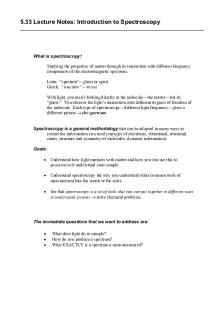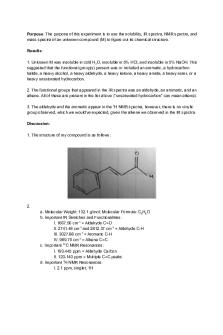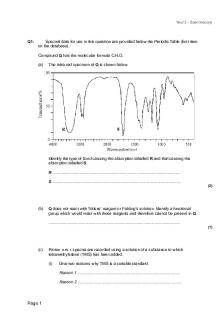UV Spectroscopy - Summary PDF

| Title | UV Spectroscopy - Summary |
|---|---|
| Course | Chemistry |
| Institution | University of Portsmouth |
| Pages | 4 |
| File Size | 111.6 KB |
| File Type | |
| Total Downloads | 120 |
| Total Views | 137 |
Summary
Summary...
Description
UV Spectroscopy
Light can be considered as a wave therefore it has wavelength, and frequency, E-m radiation is energetic; there is energy associated with it.
as frequency increases the energy increases as the wavelength increases the energy decreases. Why electromagnetic? Interaction of radiation and matter In spectroscopy we’re interested in the interactions which involve transitions between the different energy levels within atoms or molecules Measuring these interactions reveals information about the atoms or molecules: which elements are present how much is present The Spectroscopic Process In UV spectroscopy, the sample is irradiated (exposed to radiation) with the broad spectrum of the UV radiation If a particular electronic transition matches the energy of a certain band of UV, it will be absorbed The remaining UV light passes through the sample and is observed From this residual radiation a spectrum is obtained with “gaps” at these discrete energies – this is called an absorption spectrum Molar absorption coefficient - ε Dependent of the molecular structure General rules – strong for compounds with non-bonding and π orbitals Beer’s law: A=b*c*ε If ε is large -> A is large; good signal; sensitive If ε is small -> A is small; poor signal; less sensitive Can be affected by solvents
Woodward Fieser rules Predict the UV absorption wavelengths with empirically derived rules Example3:
• •
WOODWARD, R. B. 1941. Structure and the Absorption Spectra of α,β-Unsaturated Ketones. Journal of the American Chemical Society, 63, 1123-1126. FIESER, L. F., FIESER, M. & RAJAGOPALAN, S. 1948. Absorption Spectroscopy and the Structures of the Diosterols. The Journal of Organic Chemistry, 13, 800-806. • http://www.chemistry.ccsu.edu/glagovich/teaching/316/uvvis/conjugated.html Solvent effects – according to Woodward Predict solvent effects on the UV absorption wavelengths based on empirically data 1
•
•
•
WOODWARD, R. B. 1941. Structure and the Absorption Spectra of α,β-Unsaturated Ketones. Journal of the American Chemical Society, 63, 1123-1126. Additional Information for UV-Vis Spectroscopy Wide applicability Typical detection limits range from 10-4 – 10-5 M Moderate to high selectivity Good accuracy 1-5% error Ease and convenience UV and colour Colour • The portion of the EM spectrum from 400-800 nm is observable to humans - we (and some other mammals) have the adaptation of seeing colour at the expense of greater detail Visible Spectroscopy When white (continuum of ) light passes through, or is reflected by a surface, those s that are absorbed are removed from the transmitted or reflected light respectively • What is “seen” is the complimentary colors (those that are not absorbed) • This is the origin of the “color wheel” Coloured compounds Organic compounds that are “coloured” are typically those with extensively conjugated systems (typically more than five) • Consider β-carotene More coloured compounds Likewise Energy and wavelength 474 nm vs 602 nm?
λ⇧ -> E ⇩ Absorption at 602 nm means lower Energy transition than absorption at 474 nm Energy and wavelength Absorbing in the ‘red’ region means that less energy is required to elevate an electron than absorbing in the ‘yellow’ region
x x
Electrons Excited by UV-Visible Radiation Paired nonbonding electrons (N, O, S & halogens) Electrons in double or triple bonds Non-bonding, close shelled electrons Electrons in covalent single bonds.
Organic chromophores example alkane only posses -bonds and no lone pairs of electrons, so only the high energy * transition is observed in the far UV This transition is destructive to the molecule, causing cleavage of the -bond UV radiation and Electronic Excitations UV radiation causes electronic excitations Electrons move to higher energy orbitals The difference in energy between molecular bonding, non-bonding and anti-bonding orbitals ranges from 125-650 kJ/mole This energy corresponds to EM radiation in the ultraviolet (UV) region, 100-350 nm, and visible (VIS) regions 350-700 nm of the spectrum For purposes of our discussion, we will refer to UV and VIS spectroscopy as UV Practical considerations – top 3 UV spectrometers typically detect UV spectra above 210 nm Materials inside the UV spectrometer and Solvents used for the analysis obscure signals below 210 nm (means signal isn’t really seen I think?) Compounds containing unsaturated bonds (e.g. carbonyl groups, carbon/carbon double and triple bonds) can be detected by UV Typically 3 conjugated double bonds are needed for a molecule to absorb in the detectable UV region Typically 5 conjugated double bonds are needed for a molecule to absorb in the visible region -> meaning they are coloured Solvents can affect the absorption – reference samples need to be in the same solvent Conjugation summary Conjugated systems decreases the energy of electromagnetic radiation that is absorbed The more conjugated double bonds there are, the longer the wavelengths of absorbed radiation If there are enough conjugated double bonds, the molecule will start to absorb in the visible region http://mcat-review.org/molecular-structure-spectra.php What does the UV spectrum tell us about a chemical structure? Compounds containing conjugated double bonds and lone electron pairs absorb UV radiation and will give a characteristic UV spectrum The unknown compound may be identified by comparing the UV spectrum with that of a standard Solvent & pH effects may alter a UV spectrum UV can help with the structure elucidation of an organic molecule; it can confirm: presence of double bonds
Conjugation Hetero atoms (an atom that is not carbon or hydrogen.) UV does NOT provide specific structural information i.e. How many carbon atoms Substitution patterns What kind of functional groups are present UV spectrum of our powder Practical application of UV spectroscopy UV was the first organic spectral method used Today it is rarely used as a primary method for structure determination It is most useful in combination with NMR and IR data It can be used To assay (via λmax and molar absorptivity) To determine the proper irradiation wavelengths for photochemical experiments For the design of UV resistant paints and coatings The most common use of UV is as a detection device for HPLC UV is utilized for solution phase samples vs. a reference solvent easily incorporated into HPLC design
Why is UV spectroscopy important Many organic molecules have chromophores that absorb UV UV absorbance is ca. 1000 times more sensitive than NMR Still used in following reactions where the chromophore changes Useful because timescale is so fast, and sensitivity so high Kinetics, esp. in biochemistry, enzymology...
Similar Free PDFs

UV Spectroscopy - Summary
- 4 Pages

UV-Vis Spectroscopy Caffeine
- 10 Pages

Spectroscopy
- 5 Pages

Mass Spectroscopy
- 14 Pages

Spettroscopia UV
- 29 Pages

Spectroscopy Lab
- 2 Pages

Raman Spectroscopy
- 22 Pages

Spectroscopy Questions
- 116 Pages

Infrared Spectroscopy
- 3 Pages

Spectroscopy+EC 0002a
- 1 Pages

Exercícios Espectroscopia UV-Vis
- 4 Pages

Introduction to Spectroscopy 1
- 3 Pages

Atomic Absorption Spectroscopy
- 271 Pages
Popular Institutions
- Tinajero National High School - Annex
- Politeknik Caltex Riau
- Yokohama City University
- SGT University
- University of Al-Qadisiyah
- Divine Word College of Vigan
- Techniek College Rotterdam
- Universidade de Santiago
- Universiti Teknologi MARA Cawangan Johor Kampus Pasir Gudang
- Poltekkes Kemenkes Yogyakarta
- Baguio City National High School
- Colegio san marcos
- preparatoria uno
- Centro de Bachillerato Tecnológico Industrial y de Servicios No. 107
- Dalian Maritime University
- Quang Trung Secondary School
- Colegio Tecnológico en Informática
- Corporación Regional de Educación Superior
- Grupo CEDVA
- Dar Al Uloom University
- Centro de Estudios Preuniversitarios de la Universidad Nacional de Ingeniería
- 上智大学
- Aakash International School, Nuna Majara
- San Felipe Neri Catholic School
- Kang Chiao International School - New Taipei City
- Misamis Occidental National High School
- Institución Educativa Escuela Normal Juan Ladrilleros
- Kolehiyo ng Pantukan
- Batanes State College
- Instituto Continental
- Sekolah Menengah Kejuruan Kesehatan Kaltara (Tarakan)
- Colegio de La Inmaculada Concepcion - Cebu


